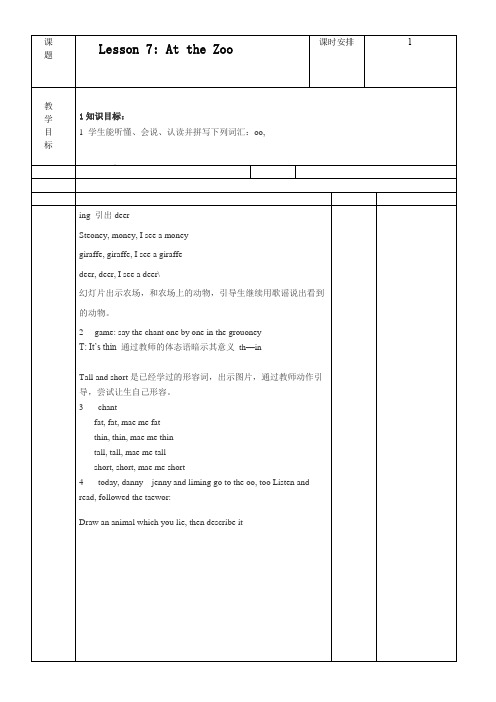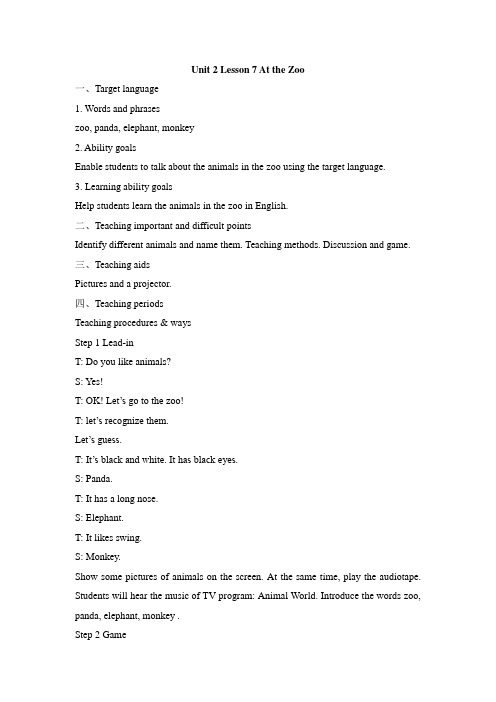Lesson7AttheZoo全英教案
- 格式:doc
- 大小:15.00 KB
- 文档页数:2




Unit 2 Lesson 7 At the Zoo一、Target language1. Words and phraseszoo, panda, elephant, monkey2. Ability goalsEnable students to talk about the animals in the zoo using the target language.3. Learning ability goalsHelp students learn the animals in the zoo in English.二、Teaching important and difficult pointsIdentify different animals and name them. Teaching methods. Discussion and game.三、Teaching aidsPictures and a projector.四、Teaching periodsTeaching procedures & waysStep 1 Lead-inT: Do you like animals?S: Yes!T: OK! Let’s go to the zoo!T: let’s recognize them.Let’s guess.T: It’s black and white. It has black eyes.S: Panda.T: It has a long nose.S: Elephant.T: It likes swing.S: Monkey.Show some pictures of animals on the screen. At the same time, play the audiotape. Students will hear the music of TV program: Animal World. Introduce the words zoo, panda, elephant, monkey .Step 2 GameAnimals Go Find three students.Panda go, panda go, panda go then elephant go . Elephant go, elephant go, elephant go then monkey go. Monkey go, monkey go, monkey go then …Ask ten volunteers to stand in the front of the classroom facing the class. The first person says... (monkey, for example). The second person says monkey and ... (tiger, for example.). The third person says monkey, tiger and ... (panda, for example.). The game continues down the row. The last person in the row must remember all of the animals’ names!Ask more groups to play the game at the front. See which group does the best or which group has the best memory. Step 3 Sing a song Practice big and small.Step 4 PresentationDescribe the pictures on the screen.For example:T: What can you see in the picture?S: Monkeys.T: Yes. They are monkeys. What are they doing now? They are eating. They are eating bananas. …Students make up more their own dialogues. …Step 5 DiscussionDiscuss the following questions in groups:1. Are the animals in the zoo happy?2. How do they feel?As students work, move around the classroom to join students.Suggested answers:1. No, they’re not happy. I think they’re sad and lonely.2. They feel lonely.Step 6 Homework Remember new words.。

Unit 2 Lesson 7 At the Zoo (教案)教学目标1.知识目标:学生能够熟练掌握本课所学的有关动物的单词:zoo panda monkey big small.2.能力目标:能够掌握并运用句型The……is……介绍动物的特征。
3.情感态度和价值观:热爱动物、关爱动物、并提高学习英语的兴趣。
学情分析本班共有24名学生,课堂纪律较好,另外,三年级学生注意力集中时间短,要想在短时间内,达到理想的教育效果,教师就要充分运用各种教学手段,将学生分散的注意力集中到一起,上课不走神,不做小动作,尽可能多的掌握知识。
重点难点1、教学重点:学生能听懂、会说、认读表示动物和描述起特征的单词: zoo, panda, monkey, elephant, big, small, fat, thin2、教学难点:运用表示大小胖瘦的单词简单描述动物的貌特征。
教学准备1、教师准备:提前候课,保持情绪饱满,为学生营造良好的学习环境做铺垫。
2、教具准备:多媒体课件动物图片教学过程【活动】组织教学1、Greeting师生简单的互相问候,尽快进入英语课堂学习。
【导入】复习2、Review(1) We Learned many animals on the farm.What animals do you know?进行师生互动对话,看谁知道的多。
注意其他同学说的时候,认真听他说的对不对,并把数目记下来。
完成之后快速做好,比一比哪个组完成得又快又好。
【讲授】新课New concept(1) New words:Zoo panda monkey elephant big动物园熊猫猴子大象大的Small小的(2) Key sentence structure:What is it?It is a\an ......The......is......Eg:The elephant is big.Eg: The monkey is thin.Eg:The bird is small.Eg: The panda is fat.【测试】游戏Practice:(1)Play a game:学习了这几个单词之后,教师安排一个“看谁反应快”的游戏,操练巩固所学知识。

英语活动教案《At the zoo》一、教学内容本节课的教学内容选自人教版PEP小学英语三年级下册第三单元《At the zoo》。
本节课主要学习动物园中常见的动物名称和它们的特征,如:tiger(老虎)、elephant(大象)、monkey(猴子)等。
同时,学生还将学习如何用英语描述动物的特征,如:It has four legs.(它有四条腿。
)和It has a long nose.(它有一个长鼻子。
)等。
二、教学目标1. 学生能够听懂、会说、会读本节课所学的动物名称和它们的特征。
2. 学生能够运用所学知识进行简单的动物特征描述。
3. 学生能够通过本节课的学习,提高自己的观察力和表达能力。
三、教学难点与重点重点:动物园中常见的动物名称和它们的特征。
难点:如何用英语描述动物的特征。
四、教具与学具准备1. 教具:动物园图片、动物卡片、录音机、磁带等。
2. 学具:动物特征描述卡片、小组活动记录表等。
五、教学过程1. 热身(5分钟)教师与学生进行简单的英语对话,如:Hello, how are you? How old are you? What's your name? 等,以此拉近师生之间的距离。
然后,教师播放本节课的录音,让学生跟随录音一起朗读课文。
2. 引入(10分钟)教师向学生展示动物园的图片,引导学生谈论动物园中的动物。
然后,教师拿出动物卡片,逐一展示给学生,让学生尝试说出动物的名称。
3. 呈现(10分钟)教师通过PPT或板书,呈现本节课所学的动物名称和它们的特征。
如:tiger(老虎)、elephant(大象)、monkey(猴子)等。
同时,教师引导学生用英语描述动物的特征,如:It has four legs.(它有四条腿。
)和It has a long nose.(它有一个长鼻子。
)等。
4. 练习(15分钟)教师将学生分成小组,每组分发一套动物特征描述卡片。
学生分组进行练习,用英语描述卡片中的动物特征。
英语活动教案《At the zoo》教案英语一、教学内容本节课选自英语教材《新概念英语》第一册第四章《At the zoo》。
详细内容包括:学习动物园中常见的动物词汇,如:elephant, tiger, lion, giraffe等;掌握一般现在时的用法,描述动物的特征和行为;学会使用“I see”句型进行观察描述。
二、教学目标1. 能够正确认读和书写本节课所学的动物词汇。
2. 运用一般现在时描述动物的特征和行为。
3. 能够用英语简单介绍自己喜欢的动物。
三、教学难点与重点重点:动物词汇的认读和书写,一般现在时的运用。
难点:句型“I see”的灵活运用,描述动物特征和行为的准确表达。
四、教具与学具准备1. 教具:PPT、卡片、磁铁、黑板、录音机等。
2. 学具:笔记本、彩色笔、词汇卡片等。
五、教学过程1. 导入:通过展示动物园的图片,引导学生用英语描述看到的动物,激发学习兴趣。
2. 呈现:教师展示PPT,呈现本节课的动物词汇,引导学生跟读并模仿。
3. 讲解:教师用一般现在时介绍动物的特征和行为,解释句型“I see”的用法。
4. 实践:学生分组,用所学词汇和句型进行角色扮演,描述动物园中的动物。
5. 练习:教师给出情景,学生用英语回答,巩固所学知识。
六、板书设计1. 动物词汇:elephant, tiger, lion, giraffe等;2. 句型:I see(描述动物的特征和行为);3. 一般现在时的肯定句、否定句和疑问句。
七、作业设计1. 作业题目:(1)用英语写一篇关于动物园的短文,至少包含5个动物词汇。
(2)用一般现在时描述家人或朋友喜欢的动物,不少于5句话。
2. 答案示例:(1)At the zoo, I see an elephant. It is big and grey. I also see a tiger. It is fierce and strong.(2)My mother likes dogs. She thinks they are friendly and loyal. My father likes pandas. He thinks they are cute and lazy.八、课后反思及拓展延伸1. 反思:关注学生在课堂上的参与度,及时调整教学方法和节奏,提高教学效果。
教案:Unit 2 Lesson 7 At the Zoo教学目标:1. 能够听懂、会说、会读本课的生词和句型。
2. 能够用英语简单描述动物的外貌和特征。
3. 能够运用所学知识,与他人交流在动物园的场景。
教学内容:1. 学习本课的生词:zoo, tiger, lion, panda, elephant, parrot, penguin, fish, bear, seal。
2. 学习本课的句型:What's that? It's a/an How many?3. 学习动物园的场景描述,运用所学知识进行交流。
教学重点与难点:1. 重点:掌握本课的生词和句型,能够用英语简单描述动物的外貌和特征。
2. 难点:能够正确运用所学知识,与他人交流在动物园的场景。
教具与学具准备:1. 教具:动物园图片、动物卡片、录音机、磁带。
2. 学具:作业本、笔。
教学过程:Step 1: 热身(5分钟)1. 教师与学生用英语进行简单的问候,营造轻松的课堂氛围。
2. 教师播放动物园的录音,让学生听录音并模仿发音。
Step 2: 生词学习(10分钟)1. 教师出示动物园的图片,引导学生说出动物园里的动物。
2. 教师出示动物卡片,学生跟读并模仿动物的声音。
Step 3: 句型学习(10分钟)1. 教师出示动物园的图片,引导学生用英语描述动物的外貌和特征。
2. 教师出示句型卡片,学生跟读并模仿句型。
Step 4: 小组活动(10分钟)1. 学生分成小组,每组选择一种动物,用英语描述动物的外貌和特征。
2. 各组轮流汇报,其他组进行评价。
Step 5: 课堂小结(5分钟)2. 学生提问,教师解答。
板书设计:1. Zoo2. Tiger3. Lion4. Panda5. Elephant6. Parrot7. Penguin8. Fish9. Bear10. Seal作业设计:1. 根据本节课所学的内容,用英语写一篇关于动物园的短文。
英语活动教案《At the zoo》教案英语一、教学内容本节课的教学内容选自人教版小学英语PEP教材,第三单元,Part A Let's learn & Let's do。
主要学习动物类词汇:tiger, panda, elephant, giraffe以及句型What's this? It's a/an和Look at It's。
二、教学目标1. 能听懂、会说、会读本节课所学的词汇和句型。
2. 能用英语简单描述动物的外貌特征。
3. 培养学生的观察力和表达能力,提高他们对英语的兴趣。
三、教学难点与重点重点:掌握动物类词汇和句型What's this? It's a/an以及Look at It's。
难点:正确发音动物类词汇和句型。
四、教具与学具准备1. 教具:多媒体课件、动物园场景图、动物卡片、录音机、磁带。
2. 学具:学生课本、练习册、画笔、彩纸。
五、教学过程1. 热身(5分钟)教师播放英语歌曲"Old MacDonald Had a Farm",引导学生跟唱,激发学生的学习兴趣。
2. 引入(10分钟)教师出示动物园场景图,引导学生观察并说出他们认识的动物。
然后教师展示动物卡片,让学生说出动物的名称。
3. 新课呈现(15分钟)教师通过课件展示本节课所要学习的词汇和句型,同时进行讲解和示范。
让学生跟读并模仿。
4. 课堂练习(10分钟)教师播放录音,学生跟随录音进行听力练习。
然后教师出示练习题,学生独立完成,教师进行讲解和反馈。
5. 小组活动(10分钟)学生分小组,用所学词汇和句型进行角色扮演,模拟在动物园的场景。
教师巡回指导并进行评价。
六、板书设计板书设计如下:What's this?It's a/anLook atIt's七、作业设计1. 抄写本节课所学的词汇和句型。
2. 运用所学词汇和句型,写一篇关于动物园的小短文。
《Lesson7:At the zoo》教学设计一、教学目标:1. 知识目标:能听说读写单词:zoo, panda, monkey, elephant, big,Small.2. 能力目标:能够在日常生活中熟练运用本课所学的动物单词。
3.情感目标:通过本课学习,培养学生了解动物、热爱动物的情感。
二、教学重难点:本课的动物单词:panda, monkey, zoo, elephant,以及形容词:big, small, fat, thin.三、教学准备:课件.四、教学过程-Class begins! Good morning class.-Good morning teacher.Step1: Greeting and ReviewT: Saturday is coming. Where do you want to go? I want to go to the….(出示zoo图片)谈话激趣,引入课题:Lesson7:At the zooStep2: New ConceptsLook, where is this? This is a zoo.(教师从字母发音出发,讲授单词zoo.兼顾听说读写四个方面。
)1.T: What animals are in the zoo? Let’s together. 以此引导出:panda, monkey, elephant.(这四个单词逐个出现)出示课件卡片(Now look at the screen.),用英语简单的和同学们进行交流。
教师通过以下步骤和方法讲解每个单词:(1)拼读。
(可以分组读,男女生比赛读)(2)讲解单词的单(single /'si gl/form)、复数(plural/'plu r l/ form)。
(3)围绕动物提问一些问题。
以panda为例:What colour is the panda? Can the panda swim?(4)书写。
Unit 2 Lesson 7 At the Zoo
一、Target language
1. Words and phrases
zoo, panda, elephant, monkey
2. Ability goals
Enable students to talk about the animals in the zoo using the target language.
3. Learning ability goals
Help students learn the animals in the zoo in English.
二、Teaching important and difficult points
Identify different animals and name them. Teaching methods. Discussion and game.
三、Teaching aids
Pictures and a projector.
四、Teaching periods
Teaching procedures & ways
Step 1 Lead-in
T: Do you like animals?
S: Yes!
T: OK! Let’s go to the zoo!
T: let’s recognize them.
Let’s guess.
T: It’s black and white. It has black eyes.
S: Panda.
T: It has a long nose.
S: Elephant.
T: It likes swing.
S: Monkey.
Show some pictures of animals on the screen. At the same time, play the audiotape. Students will hear the music of TV program: Animal World. Introduce the words zoo, panda, elephant, monkey .
Step 2 Game
Animals Go Find three students.
Panda go, panda go, panda go then elephant go . Elephant go, elephant go, elephant go then monkey go. Monkey go, monkey go, monkey go then …
Ask ten volunteers to stand in the front of the classroom facing the class. The first person says... (monkey, for example). The second person says monkey and ... (tiger, for example.). The third person says monkey, tiger and ... (panda, for example.). The game continues down the row. The last person in the row must remember all of the animals’ names!
Ask more groups to play the game at the front. See which group does the best or which group has the best memory. Step 3 Sing a song Practice big and small.
Step 4 Presentation
Describe the pictures on the screen.
For example:
T: What can you see in the picture?
S: Monkeys.
T: Yes. They are monkeys. What are they doing now? They are eating. They are eating bananas. …
Students make up more their own dialogues. …
Step 5 Discussion
Discuss the following questions in groups:
1. Are the animals in the zoo happy?
2. How do they feel?
As students work, move around the classroom to join students.
Suggested answers:
1. No, they’re not happy. I think they’re sad and lonely.
2. They feel lonely.
Step 6 Homework Remember new words.。